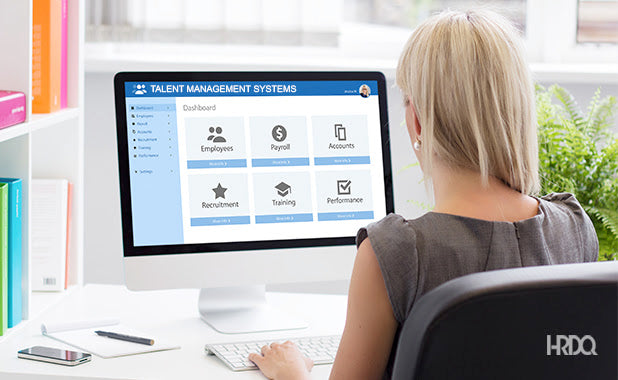Share
Hiring Guide: What Is a TMS (Talent Management System)?
Bradford R. GlaserGood human resources management keeps a business ticking, right? A Talent Management System (TMS) is often the go-to tool. It guides workforce development from start to finish. So, what exactly is a TMS? It's a system built to help businesses manage their most valuable asset: their employees.
It's pretty tough for organizations to not only find great talent but also manage, help grow, and keep them. That's where a TMS comes in. It does more than monitor employees. It aligns their goals with the company's ambitions. This system can also spotlight potential leaders. As you might imagine, it keeps employees engaged throughout their career path.
We want to teach you a thing or two about TMS. It can make HR processes simpler and enrich employees' experiences. A TMS can also nurture a learning and growing culture. Let's jump into how this system can transform traditional HR tasks into a data-driven, employee-centric approach. We'll provide handy findings for businesses eager to use or improve their talent management systems.

- Identify personal leadership styles
- Capitalize on style strengths
- Minimize style trouble spots
Table of Contents
What Are Talent Management Systems?
Talent management systems (TMS) are the go-to for all HR tasks. They are tech-driven multitaskers who manage all aspects, from hiring to retiring. As you might imagine, their main focus involves identifying potential talent and supporting their growth in your company. You could look at them as your digital helper in forming a successful workplace.
TMSs want to detect and foster talent, not just fill job positions. These platforms present many tools to guide an employee's path in your company at every milestone. They include functions like performance tracking, determining training requirements, or preparing for future leadership roles.
The real charm of these systems is their smooth combination with other HR tasks. For instance, when attaching to payroll or benefits administration software, you receive a comprehensive view. This complete picture enables you to manage talent better because nobody prefers switching between multiple programs for a single task.

Diving deeper into what makes up these robust systems:
- Performance Management: It keeps tabs on employees' progress so leaders can swoop in with recognition or guidance at the right time.
- Learning and Development: This is where potential blooms. With access to courses and training modules tailored for skill-building, career growth has many uses beyond possible – it's inevitable.
- Succession Planning: Like chess masters thinking five moves ahead, companies use this feature to prepare today for tomorrow's leadership gaps before they become issues.
Sure enough, a well-oiled TMS doesn't miss out on spotting high-flyers destined for great things. But don't be fooled by its structured exterior; modern TMS solutions have evolved far beyond mere spreadsheets and databases – they now flaunt AI smarts capable of predicting which employees might be thinking about hitting the road soon or which new hire could be CEO material down the line. That means better decisions are made faster – and less guesswork all around when building teams set up for success.
We've come a long way since "personnel management" was merely about tracking vacation days without any fancy algorithms involved – now we're looking at cutting-edge platforms weaving together big data analytics with human insights that make sense even if you flunked statistics back in college.
The Evolution of Talent Management Systems
Remember the good old days when managing talent was as simple as keeping a few paper files in a cabinet? Gone are the days of paper files; today's HR professionals have access to advanced technology in the form of a Talent Management System. A Talent Management System (TMS) is now the Iron Man suit for HR professionals—equipped with high-tech gadgets to tackle everything from hiring superheroes to nurturing their growth.
Talent management used to be more like gardening – carefully planting seeds and hoping they'd grow into something impressive. But it's 2023; we've traded our watering cans for AI-powered insights. The shift began subtly enough – with software replacing spreadsheets – but then came cloud computing, launching TMS capabilities into the stratosphere.
Today's systems are no one-trick ponies; they're full-blown circuses of features. We've got performance management that tracks how you're doing and predicts your potential peaks like a seasoned fortune teller. Learning and development tools have evolved too – from stale PowerPoints to interactive platforms where employees can play games or watch videos at their pace because, let's face it, who doesn't want learning that feels less like school and more like Netflix?

We've watched TMSs morph from clunky databases into sleek engines that drive strategic decision-making using analytics sharper than a sushi chef's knife. And what does this mean for organizations? They get clearer visibility on their workforce, so making smart decisions becomes second nature – a bit like choosing avocado toast over cereal for breakfast: It just makes sense.
If anything is evident through this evolution – it's that TMS has many uses beyond changing the game; it is the game. As technology gallops ahead, expect these systems to become even smarter and maybe even develop personalities (friendly ones, we hope). So grab your popcorn, people – the future of talent management promises quite the show.
How TMS Improves Hiring Processes
Imagine a TMS as your company's matchmaking guru. It's got the smarts to help you find "the one" – or, in this case, the right hire – with less hassle and more flair.
A good TMS doesn't just track applicants; it transforms recruitment into an experience that feels like swiping right on success. It cuts through the noise by sorting resumes with laser precision. That means only candidates who fit your must-haves get through. And let's face it: nobody has time for maybes when hunting top talent.
The candidate path gets a significant upgrade, too. Instead of feeling lost in digital space, job seekers stay informed with timely updates from the first click to a final handshake – or thumbs-up emoji if that's more your style. They can easily see where they stand because no one likes being left on read, especially eager applicants.
Your hiring funnel is like a bespoke suit – it needs tailoring to each role for that perfect fit. A solid TMS helps craft personalized messaging at every stage, so candidates feel seen and heard – not just another cog in the machine.

We all know feedback makes us better, and faster feedback during recruitment – that's gold dust. By leveraging analytics within a TMS, HR pros spot bottlenecks quickly and tweak processes before they turn into roadblocks or, worse – ghost towns where great potential goes MIA.
Gone are days of gut-feel hiring decisions. With robust reporting features baked into today's TMs systems (and we're not talking muffins here), data-driven insights are served hot & fresh directly to decision-makers tables.
Comparing metrics across past hires lets teams pinpoint what works and ditch what doesn't because throwing spaghetti at walls hoping something sticks isn't exactly strategic planning now, is it?
Clever algorithms don't just predict weather – they forecast which applicant might be tomorrow's superstar employee. Think Moneyball but for your workforce, and you've got the idea. Tapping into advanced analytics is like having a crystal ball that guides better choices and reduces mismatched hire risk. Who now wants that kind of power at their fingertips?
Integration with Other HR Systems
Think of a TMS as the maestro of an orchestra, where every musician is an HR tool. It's not just about having first-chair violinists; it's how they harmonize with the brass, woodwinds, and percussion that creates a symphony. In the same way, a TMS isn't worth its salt if it can't play nice with payroll systems or benefits administration.
The magic happens when these tools talk to each other. Let's say you've got payroll software humming along—now integrate your TMS and watch data flow like notes on a score sheet. With this duet in place, salary changes from performance reviews update seamlessly because communication between systems is vital.
We're talking serious harmony here.
Gone are the days of manual updates after performance evaluations. A good TMS streamlines processes, automatically adjusting pay scales based on employee achievements without missing a beat.
This integration also means less time fixing errors – a dream come true for any HR professional who knows the nightmare of incorrect paychecks due to input slip-ups.

Your employees won't miss out on their well-earned perks either. Integrating your TMS with benefits administration will ensure that once someone hits that work anniversary or promotion milestone, their benefit upgrades kick in immediately.
No more delays or misunderstandings among team members. Now, there's immediate appreciation, making every person feel acknowledged right away for their dedication and effort.
Handling the absences becomes easier when everything is connected. Spotting habits and trends becomes quicker than you might imagine. Balancing the work schedules with employee growth plans will ensure that no one is too overloaded or unnoticed.
They don't overlook overtime requests anymore, as they're planned into future training sessions scheduled through your combined system. A seamless transition, don't you think?
How to Choose the Right TMS for Your Organization
Finding the perfect TMS is like picking out a new smartphone. Seeking a TMS that is not just clever but also user-friendly, one which will simplify your life rather than complicate it should be the goal.
Prioritize what matters most to your organization. Do you need a system that grows with you? Something user-friendly so even Bob from accounting can use it without breaking into a sweat? Or maybe support from the vendor is essential because let's face it – tech hiccups happen when we least expect them.
Analyze your company size and culture. A startup with a team of ten doesn't play by the same rules as an enterprise with thousands on board. If your company values innovation, look for a TMS with cutting-edge features like AI-driven analytics or mobile accessibility options.
You probably wouldn't buy a brand-new, flashy phone simply because it catches your eye, right? Well, you should think about it. Of course, you'd inspect its features and capabilities, too. The same principle applies when picking out a new Talent Management System (TMS). Decide if the chosen system is equipped with the right tools.
You need to wonder a few things. Can job candidates apply with ease? Can the managers set up performance reviews without facing any hiccups? You see, these are the aspects you need to think about.

Let's chat about scalability and integration capabilities now. You need a system that gets along well with any other software you use at work, like payroll or workforce management software. Picture it like a well-oiled machine where all the HR technologies work harmoniously together.
Now, don't forget about backup. We're not talking about data here; we're referring to the vendor. Imagine for a moment you're in the middle of setting up the system and encounter issues. That's when the vendor's strong support becomes valuable. You don't want to end up regretting your purchase. Hence, asking difficult questions before making the final decision is a good idea.
The right TMS system for your business will depend a lot on the size and nature of your business. So, knowing your business's traits first is essential. Don't get swayed by the glossy brochures; investigate the features thoroughly. Furthermore, keep in mind to consider the potential growth of your business in the future.
The importance of customer service cannot be underestimated. It can be the support you require when you need help the most. So, don't forget about that, either.
The Impact of TMS on Engagement and Retention
Think about a TMS as the backstage crew of a hit Broadway show. It's not just there to put names on seats but to ensure every performance is spot-on, leaving the audience – your employees – wanting more. A solid TMS doesn't just track who showed up for work; it turns everyday jobs into starring roles where each employee feels valued.
A great TMS ramps up engagement by personalizing career development paths. As Netflix suggests shows you might like, a good TMS recommends training programs tailored to individual skills and aspirations. This personalized approach can lead to higher job satisfaction because when your company gets you, sticking around seems like an easy choice.

But that's not all – a well-oiled TMS can be the difference between keeping your top talent or watching them take their final bow elsewhere. Data from HR Dive supports this with findings showing organizations with strong learning cultures enjoy employee retention rates 30-50% higher than those that don't invest in people's growth.
We're talking better hires, too, since modern systems give recruiters an X-ray vision of candidates' potential beyond what resumes reveal. So yes, they help ensure new recruits fit right in—and stick around longer, too. And if you've ever seen how quickly word spreads at water coolers or Slack channels, you'll know having satisfied employees buzzing about how much they love their jobs is way better PR than any corporate brochure could hope for.
If engagement were a cake (who doesn't love cake?), retention would surely be the icing on top – it looks good and tastes even better over time as businesses reap benefits from lower turnover costs and deeper pools of institutional knowledge kept intact within teams.
Wrapping Up
We've taken a pretty deep jump into what makes talent management systems tick. By now, you should see how these powerful tools are game changers in the HR arena, bringing everything from hiring to retirement under one tech-savvy roof.
Keep this in mind when we talk about the core components. They're like different spices that make up a killer recipe for organizational success. From performance evaluations that help pinpoint who's ready for bigger things to learning modules that fuel personal growth – these features aren't just nice-to-haves; they're must-haves.
Choosing the right TMS is no small feat either – it's like finding jeans that fit perfectly without trying them on. You want something scalable, user-friendly, and backed by solid support because nobody likes being left on hold with "elevator music" playing endlessly. Get this choice right, and you'll have more than just an efficient system; you'll have happy employees who stick around because they feel valued and understood.

If there's anything as constant as change itself, it's technology trends shaping our future workplaces - and TMS is riding shotgun on this path. With predictive analytics steering us away from costly misfires in recruitment or retention strategies, machine learning giving us insights we never knew we needed, and mobile accessibility making sure opportunities are always at our fingertips – staying ahead of these trends has many uses beyond smart; it's essential.
To put all this knowledge into practice, though, you need top-notch resources at your disposal. Why not check out or take your leadership skills up a notch with our What's My Leadership Style assessment? By engaging with this assessment, you'll gain valuable insights into your unique leadership qualities, helping you to lead more effectively and inspire those around you.





















































